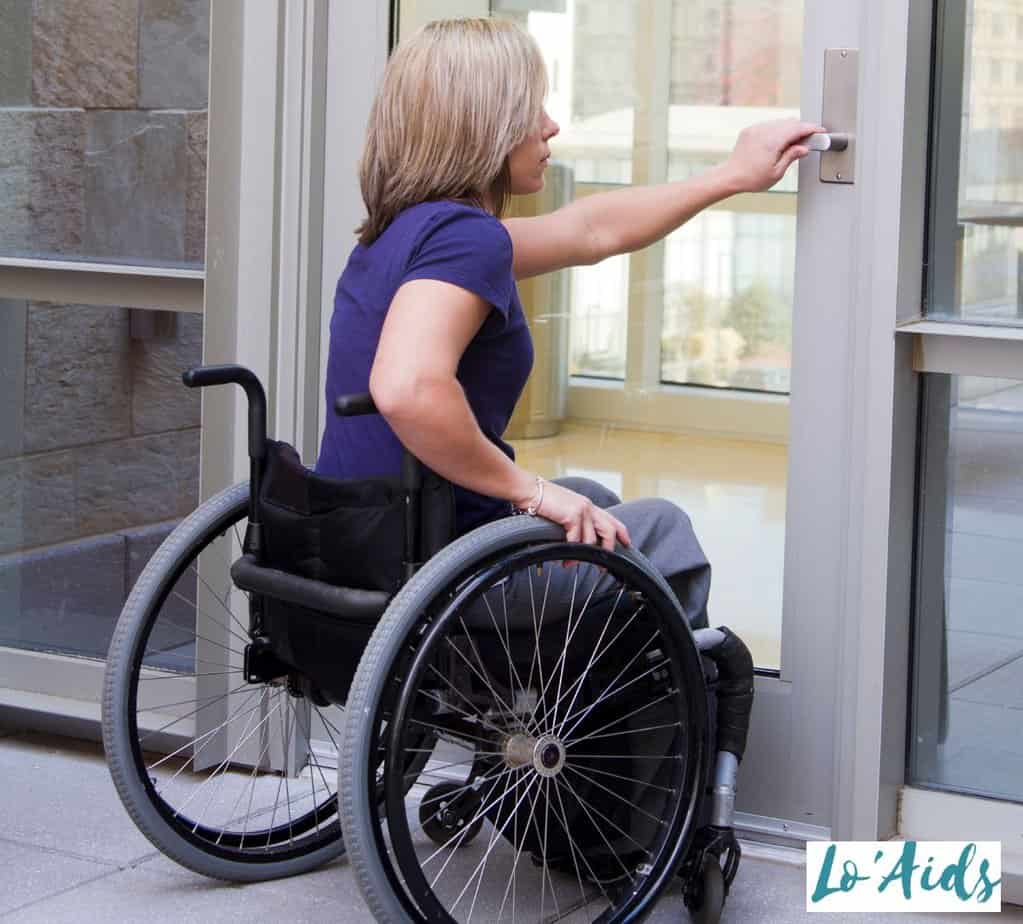Eager to know how to protect door frames from wheelchair damage? Hear me out!
Harvard Health highlights that “In a study of 591 wheelchair users with spinal cord injuries, 64% reported requiring at least one wheelchair repair in the past six months,” an outcome I’ve often seen as an experienced caregiver (But there’s hope!)… [1]
In this article, I’ll guide you on ensuring your door frames remain undamaged, strong, and durable.
Dive in to discover the magic keys to preventing door frame damage TODAY!
Table of Contents
Key Takeaways
- Install door frames made of impact-resistant materials, such as metal or hardwood.
- Use heavy-duty hinges designed to support the weight of a wheelchair user and provide additional support.
- Secure the door frames using anchor bolts, which securely attach them to the wall and provide additional support.
How to Protect Walls from Wheelchair Damage | 6 DIY Tricks To Powerful Door Frames
Solutions are available to protect door frames from wheelchair damage, such as wall guards and corner protectors. For an optimal barrier, install wall protectors and use wheelchair-friendly wall coverings to safeguard your door frames effectively.

Let’s break it down in more detail…
1. Wall Guards
Safeguarding door frames from the persistent impact of wheelchairs necessitates a robust solution: wall guards.
These protective elements, forged from resilient materials such as stainless steel and durable vinyl sheets, are strategically positioned along the base of walls.
Their primary function? To provide unwavering defense against daily wear and tear.
Above all, they’re so easy to install, adaptable to screws or adhesive tape methods.
Similarly, their availability in diverse hues ensures a seamless integration with any interior décor.
In essence, for those seeking a blend of functionality and aesthetic unity, wall guards present a prudent choice to preserve the integrity of door frames amidst frequent wheelchair use.
2. Corner Protectors
For door frames, their corners remain the most susceptible to damage. Enter corner protectors – precisely crafted to fortify these delicate junctures….
Their presence guarantees that those navigating wheelchairs through confined spaces can do so confidently, without those pesky concerns of marring the door frame or sustaining injuries.
Among the installation benefits is their simplicity, further enhanced by the myriad of material choices such as robust metals, cushioning foam, resilient rubber, and versatile plastic.
While plastic variants are economically favorable and offer an extensive range of shapes to fit various door frames, the rubber ones command attention for bustling areas…
In fact, their inherent strength and shock-absorption capabilities place them a notch above, ensuring prolonged protection for door frame corners.
3. Wall Covering
For those who seek to minimize damage to walls, the allure of wheelchair-friendly wall coverings, such as vinyl sheets or textured wall paint, becomes evident.
These selections don’t merely guard the door frames. AND YES, they introduce an enhanced layer of resilience against the occasional wheelchair-induced nicks and grazes.
As you tread the path of interior finesse, ensure your chosen wall covering melds seamlessly with your design aesthetic while championing enduring protection.
The realm of vinyl sheets, diverse in hues, designs, and textures, provide their mettle by offering effortless cleaning and a barrier against wheelchair abrasions…
On the other spectrum lies textured wall paint, a direct application to door frames, with its matte finish curtailing any unwanted overhead light reflections— sidestepping potential glare.
These solutions, whether for commercial or healthcare purposes, effectively protect your structure by preserving the integrity of wall corners and providing superior protection.
4. Aluminum Rail Guard
An aluminum chair rail wall guard is a great option for protecting door frames in commercial and healthcare facilities.
But why use them?
In a study of predictors of assistive technology abandonment, researcher Phillips and team found that mobility aids were more frequently abandoned than any other device category, and poor device performance was significantly related to abandonment [2].
Thanks to a rail guard, your wheelchair is optimally protected from this fate…
These guards are pre-drilled with holes, making installation quick and easy. They offer excellent protection while blending seamlessly with the pre-existing wall design. Let’s see how they’re made…
Aluminum rail guards are made of a robust, lightweight metal that is durable and corrosion-resistant metal.
This makes them ideal for protecting door frames from the wear and tear caused by wheelchair use.
Surprisingly, the guard’s textured finish provides extra grip to help reduce scratches and dents.
As you can see, the aluminum rail guard is an economical, long-term solution for protecting door frames from wheelchair damage.
5. Installing Corner Guards
When installing corner guards, following the manufacturer’s instructions meticulously is important. Ensure that the guards are accurately measured, marked, and securely attached to the door frame.
Inspect the guards regularly for any damage or signs of wear and replace them if needed to ensure continuous protection.
When choosing corner guards, it is important to select a material that is durable enough to withstand the force of a wheelchair while also providing a smooth and padded surface.
Plastic or rubber guards are typically more durable than foam-based models but may look less appealing.
Also, consider using floor protection mats in front of door frames and other areas where wheelchairs may come into contact with the floor.
6. Scuff-Resistant Paint
When it comes to protecting door frames from wheelchair damage, many people think of installing physical barriers such as stainless steel wall protectors or edge guards.
Nonetheless, check out that the point is both aesthetically pleasing, functional, and, above all, scuff-resistant paint.
While paint primarily enhances a property’s aesthetic appeal, it can also protect against damage.
By selecting the right type of paint, you can effectively prevent scratches and scuffs on your walls – including door frames prone to wheelchair contact.
Still curious about anything? Then, speak to a professional painter.
They have the expertise to guide you in selecting the right paint that can withstand the impacts of wheelchair use.
First, check out this video for some more glittery hacks…
NEXT: Let’s tackle some common questions….
Frequently Asked Questions
1. How can I protect door frames from wheelchair damage?
To protect door frames from wheelchair damage, consider installing door frame protectors or door jamb protectors.
2. Can wheelchair damage be prevented in narrow hallways?
Yes, wheelchair damage can be prevented in narrow hallways.
One solution is to install narrow hallway protectors, which are specially designed to provide continuous protection along the entire length of the hallway walls.
3. How can I protect door frames in commercial facilities or healthcare facilities?
Consider using commercial-grade door frame protectors designed to withstand heavy usage to protect door frames in these settings.
4. How can I protect door frames while maintaining the original wall design?
Try using chair rail, wall guards. These guards are available in various styles, including silhouette, supreme, and aluminum chair rail wall guards.
Conclusion
Learning how to protect door frames from wheelchair damage is crucial for a safe and durable door frame…
You can prevent unsightly and costly damage by implementing a few simple strategies, such as using door frame protectors.
In fact, installing stainless steel or aluminum chair rail wall guards is a recommended method for safeguarding door frames.
The guards act as a protective barrier between the wheelchair and the door frame, preventing potential damage.
Additionally, they offer a polished and sophisticated aesthetic, improving the overall visual appeal of your area.
As always, if you’ve any clever tips, share them in the comments below and blow my mind!
Until next time…
Resources
1. MSc LII MD. Millions rely on wheelchairs for mobility, but repair delays are hurting users [Internet]. Harvard Health. 2022. Available from: https://www.health.harvard.edu/blog/millions-rely-on-wheelchairs-for-mobility-but-repair-delays-are-hurting-users-202207212785
2. Fitzgerald SG, Collins DM, Cooper RA, Tolerico M, Kelleher A, Hunt P, et al. Issues in maintenance and repairs of wheelchairs: A pilot study. The Journal of Rehabilitation Research and Development [Internet]. 2005 [cited 2023 Sep 17];42:853. Available from: https://www.academia.edu/13700938/Issues_in_maintenance_and_repairs_of_wheelchairs_A_pilot_study





